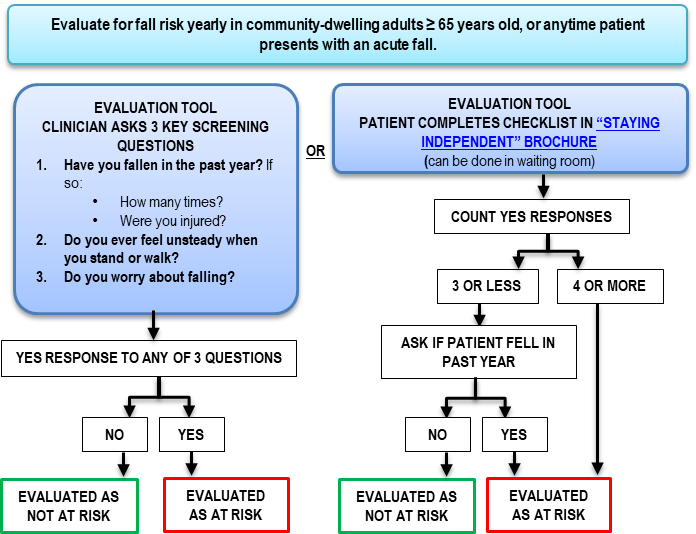Dementia Fall Risk for Dummies
5 Simple Techniques For Dementia Fall Risk
Table of ContentsDementia Fall Risk for DummiesDementia Fall Risk for BeginnersA Biased View of Dementia Fall RiskHow Dementia Fall Risk can Save You Time, Stress, and Money.
An autumn risk evaluation checks to see exactly how likely it is that you will certainly fall. The evaluation typically consists of: This includes a collection of questions concerning your total health and if you have actually had previous falls or troubles with balance, standing, and/or strolling.STEADI consists of testing, evaluating, and intervention. Treatments are recommendations that may decrease your risk of dropping. STEADI includes three actions: you for your threat of succumbing to your risk aspects that can be boosted to attempt to stop drops (for instance, balance troubles, damaged vision) to reduce your risk of falling by making use of efficient strategies (as an example, supplying education and learning and sources), you may be asked numerous concerns including: Have you fallen in the past year? Do you feel unstable when standing or strolling? Are you bothered with falling?, your copyright will certainly check your stamina, balance, and gait, using the following autumn analysis tools: This examination checks your stride.
You'll sit down once again. Your service provider will certainly inspect for how long it takes you to do this. If it takes you 12 secs or more, it may suggest you are at higher risk for a loss. This examination checks strength and equilibrium. You'll rest in a chair with your arms crossed over your breast.
Relocate one foot midway ahead, so the instep is touching the huge toe of your various other foot. Move one foot fully in front of the other, so the toes are touching the heel of your various other foot.
How Dementia Fall Risk can Save You Time, Stress, and Money.
The majority of drops happen as an outcome of multiple adding factors; consequently, managing the threat of falling begins with identifying the factors that contribute to fall danger - Dementia Fall Risk. Some of the most relevant threat variables consist of: History of prior fallsChronic clinical conditionsAcute illnessImpaired gait and balance, lower extremity weaknessCognitive impairmentChanges in visionCertain high-risk drugs and polypharmacyEnvironmental elements can additionally boost the danger for drops, including: Inadequate lightingUneven or harmed flooringWet or unsafe floorsMissing or damaged handrails and get barsDamaged or incorrectly fitted equipment, such as beds, mobility devices, or walkersImproper use assistive devicesInadequate supervision of the people staying in the NF, consisting of those that show aggressive behaviorsA moved here successful autumn threat monitoring program calls for an extensive medical analysis, with input from all members of the interdisciplinary team

The care strategy need to additionally consist of treatments that are system-based, such as those that advertise a safe setting (ideal lighting, handrails, get bars, and so on). The efficiency of the interventions ought to be evaluated occasionally, and the treatment plan changed as essential to mirror changes in the loss risk evaluation. Carrying out a fall risk management system utilizing evidence-based ideal practice can decrease the frequency of falls in the NF, while restricting the possibility for fall-related injuries.
Dementia Fall Risk for Beginners
The AGS/BGS guideline suggests screening all adults matured 65 years and older for autumn danger every year. This testing is composed of asking people whether they have fallen 2 or even more times in the past year or sought clinical attention for an autumn, or, if they have not dropped, whether they feel unsteady when walking.
People that have actually dropped as soon as without injury needs to have their balance and gait evaluated; those with stride or equilibrium problems must get added assessment. A history of 1 fall without injury and without stride or balance issues does not necessitate more evaluation past continued yearly autumn danger testing. Dementia Fall Risk. A fall threat assessment is needed as component of the Welcome to Medicare exam

Not known Incorrect Statements About Dementia Fall Risk
Documenting a drops history is one of the high quality signs for loss prevention and monitoring. copyright medications in specific are independent predictors of drops.
Postural hypotension can often be relieved by lowering the dosage of blood pressurelowering drugs and/or stopping medications that have orthostatic hypotension as a negative effects. Use of above-the-knee assistance pipe and copulating the head of the bed boosted might also lower postural decreases in high blood pressure. The recommended components of a fall-focused physical evaluation are received Box 1.

A Pull time better than or equivalent to 12 seconds suggests high fall risk. Being not able to stand up from a chair of knee height without using one's arms indicates raised autumn danger.